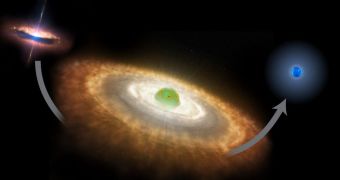According to the conclusions of a new scientific study, it would appear that stable equilibrium is the operative concept when it comes to the formation of new stars. Even if they form from immense hydrogen clouds, they tend to shrink until they reach a balance.
This is also true for massive stars, of the type that are several times heavier than the Sun. Astronomers strongly believed that these objects formed in their final configuration from the get-go, and maybe even grew a little after that.
What the new study suggests is that this is not the case. Experts at the University of Amsterdam were recently able to observe a massive star in the process of forming, and found that the object tends to shrink after forming, until it reaches a state of equilibrium.
The particular star on which their work focused lies in the Omega Nebula, a stellar nursery also known as the Swan Nebula or Messier 17. The object is called B275, and is located in the direction of the Sagittarius constellation, about 5,500 light-years away from the Sun, Space reports.
Conducting investigations such as this one is extremely difficult, since protostars form inside very thick clouds of molecular hydrogen gas and cosmic dust. Visible-light wavelengths cannot penetrate to their locations, and so X-ray, radio, gamma-ray and infrared observatories have to be used.
For this particular research, the team used ultraviolet and infrared data collected by the X-shooter spectrograph on the Very Large Telescope (VLT). The installation is located at the Paranal Observatory, in Chile, a facility managed by the European Southern Observatory (ESO).
“The large-wavelength coverage of X-shooter provides the opportunity to determine many stellar properties at once, like the surface temperature, size, and the presence of a disk,” explains Bram Ochsendorf, who was the lead author of the work.
Statistically, B275 is different from similar objects through the fact that it's about 300 percent larger than massive stars that are themselves 7 times heavier than the Sun. However, the latter have reached their main sequence, meaning that they are stable, and that they convert hydrogen to helium.
What this study implies is that these stars are a lot bigger when they form than they are during the main sequence. According to the team, the adjustment occurs during a stage in their lives when their accretion disks disappear, the surrounding clouds clear, and the stars themselves become visible.
Ochsendorf – who carried out the new research as part of his master's thesis – believes that this is the point B275 is at now. Interestingly, surface temperatures on the star are a lot lower than would be expected of a star about 1,600 times more luminous than the Sun, Space reports.
Details of the new investigation were made public in the December 2 issue of the esteemed scientific journal Astronomy & Astrophysics.
“This is a beautiful confirmation of new theoretical models describing the formation process of massive stars, obtained thanks to the extreme sensitivity of X-shooter,” UA astronomy professor Lex Kaper adds.

 14 DAY TRIAL //
14 DAY TRIAL //